-
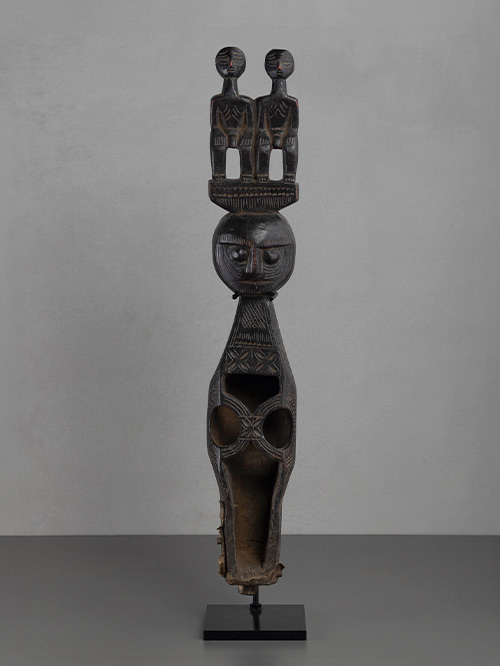
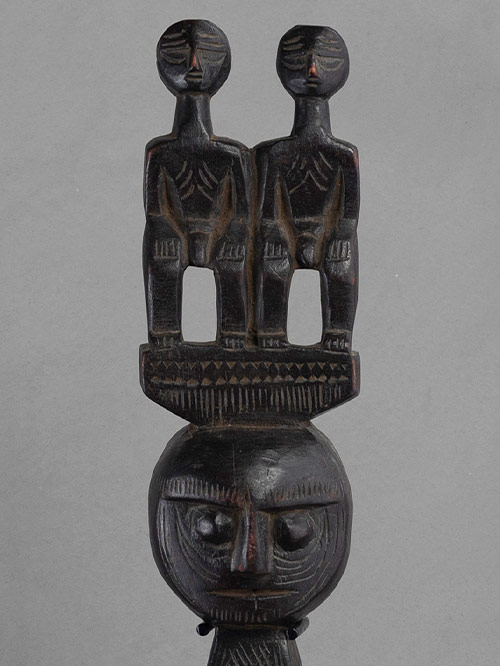
Santhals (North-Eastern India)
wood
This striking wooden instrument with an anthropomorphic form features a peg box in the shape of a tattooed head atop a shaped resonator. Atop the head, a finial depicts a pair of standing figures. Incised geometric and floral decorations cover every surface of the instrument. Traces of the original resonator covering, most likely made from buffalo or goat hide, still remain on the bottom of the resonator.
The Santhals are the largest tribal community who live in the Indian states of Bihar, Orissa and West Bengal. Music is an important part of Santhal culture and the Santhal are gifted and passionate dancers and musicians and most of their songs and dances are related to various seasons and phases of life. A variety of sculptural instruments are used by the tribe, the most unique of which are the dhodro banam (hollow instrument).
The Santhal believe they are physically related to the dhodro banam and consider the instrument to be a human being. The dhodro banam is made of a single piece of wood, divided as such into distinct body parts such as the belly flanked with arms, open ribcage and a long neck ending in a head. The head is the key block and is often beautifully carved in the shape of a human head, a couple or whole groups of humans or animals.
The dhodro banam player holds the instrument vertically with its neck pointing upwards and the playing hand above the bow hand. The bow (banam ak) is made with horsehair and the string, and when strung brings life into the instrument through its vibrations.
Size (cms): 74(H) x 13(W) x 18(D)
Size (inches): 29(H) x 5(W) x 7(D)
-

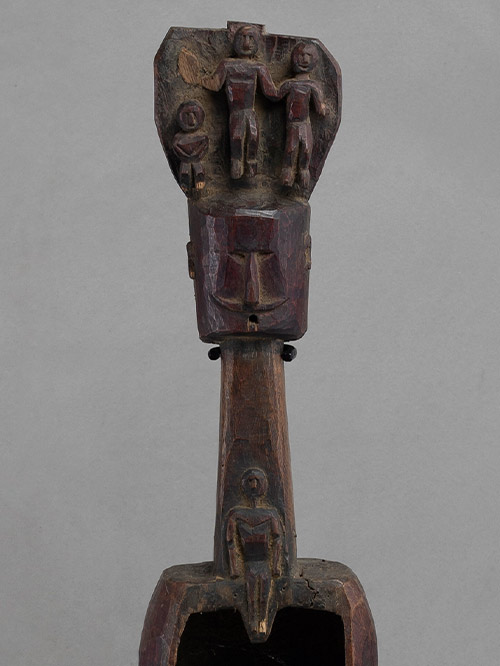
Santhals (North-Eastern India)
wood
This spectacular wooden instrument with an anthropomorphic form features a peg box in the shape of a moustachioed man atop a shaped resonator. Atop the head, a finial depicts three cheerful figures, potentially symbolising a family. The handle, worn from use, connects the peg box and resonator and is adorned with a depiction of a standing man. The original resonator covering, most likely made from buffalo or goat hide, still covers the lower half of the resonator. On either side of the resonator, intricate carvings feature a bird perched atop a tree.
The Santhals are the largest tribal community who live in the Indian states of Bihar, Orissa and West Bengal. Music is an important part of Santhal culture and the Santhal are gifted and passionate dancers and musicians and most of their songs and dances are related to various seasons and phases of life. A variety of sculptural instruments are used by the tribe, the most unique of which are the dhodro banam (hollow instrument).
The Santhal believe they are physically related to the dhodro banam and consider the instrument to be a human being. The dhodro banam is made of a single piece of wood, divided as such into distinct body parts such as the belly flanked with arms, open ribcage and a long neck ending in a head. The head is the key block and is often beautifully carved in the shape of a human head, a couple or whole groups of humans or animals.
The dhodro banam player holds the instrument vertically with its neck pointing upwards and the playing hand above the bow hand. The bow (banam ak) is made with horsehair and the string, and when strung brings life into the instrument through its vibrations.
Size (cms): 75(H) x 15(W) x 17(D)
Size (inches): 29.5(H) x 6(W) x 6.5(D)
-
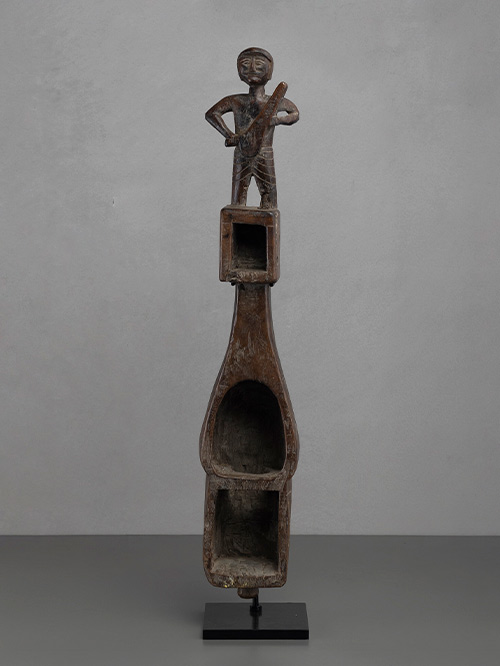
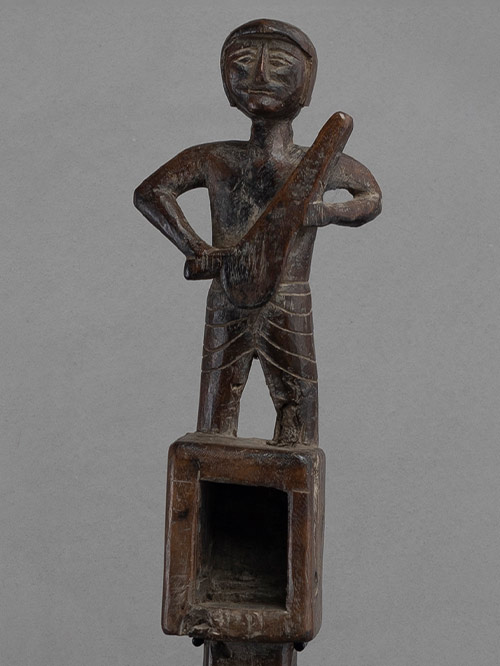
Santhals (North-Eastern India)
wood
An unusual instrument designed with a finial above the peg box depicting a standing figure playing a Dhodro banam instrument.
The Santhals are the largest tribal community who live in the Indian states of Bihar, Orissa and West Bengal. Music is an important part of Santhal culture and the Santhal are gifted and passionate dancers and musicians and most of their songs and dances are related to various seasons and phases of life. A variety of sculptural instruments are used by the tribe, the most unique of which are the dhodro banam (hollow instrument).
The Santhal believe they are physically related to the dhodro banam and consider the instrument to be a human being. The dhodro banam is made of a single piece of wood, divided as such into distinct body parts such as the belly flanked with arms, open ribcage and a long neck ending in a head. The head is the key block and is often beautifully carved in the shape of a human head, a couple or whole groups of humans or animals.
The dhodro banam player holds the instrument vertically with its neck pointing upwards and the playing hand above the bow hand. The bow (banam ak) is made with horsehair and the string, and when strung brings life into the instrument through its vibrations.
Size (cms): 70(H) x 13(W) x 13(D)
Size (inches): 27.5(H) x 5(W) x 5(D)
-
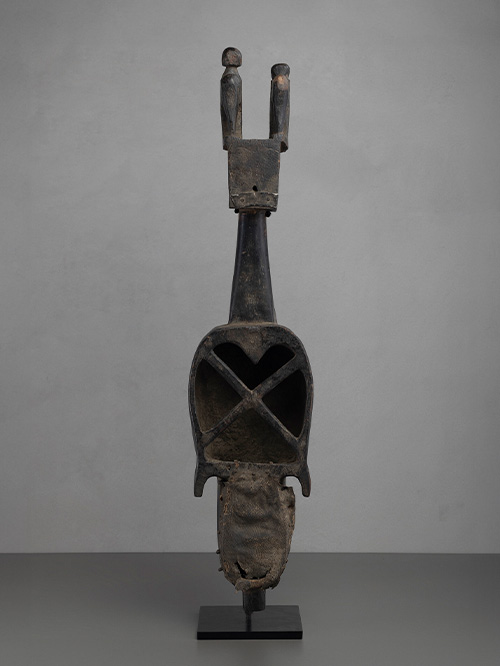
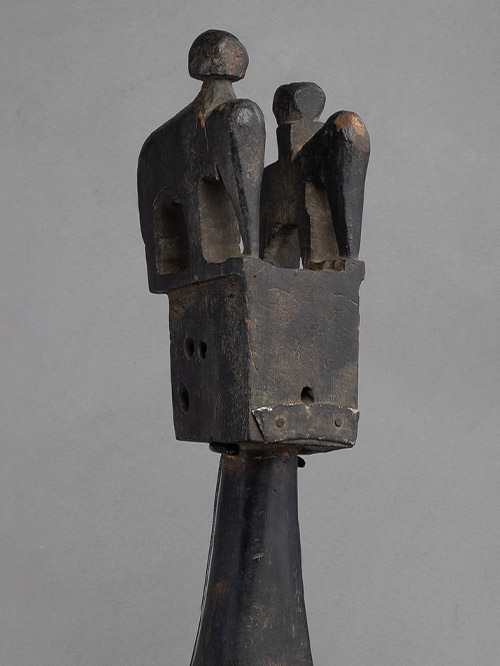
Santhals (North-Eastern India)
wood
A patinated wooden instrument, carved with a finial above the peg-box, depicting two riders atop elephants. The bottom half of the resonator is skin covered, most probably buffalo or goat hide.
The Santhals are the largest tribal community who live in the Indian states of Bihar, Orissa and West Bengal. Music is an important part of Santhal culture and the Santhal are gifted and passionate dancers and musicians and most of their songs and dances are related to various seasons and phases of life. A variety of sculptural instruments are used by the tribe, the most unique of which are the dhodro banam (hollow instrument).
The Santhal believe they are physically related to the dhodro banam and consider the instrument to be a human being. The dhodro banam is made of a single piece of wood, divided as such into distinct body parts such as the belly flanked with arms, open ribcage and a long neck ending in a head. The head is the key block and is often beautifully carved in the shape of a human head, a couple or whole groups of humans or animals.
The dhodro banam player holds the instrument vertically with its neck pointing upwards and the playing hand above the bow hand. The bow (banam ak) is made with horsehair and the string, and when strung brings life into the instrument through its vibrations.
Size (cms): 88(H) x 19(W) x 17(D)
Size (inches): 34.5(H) x 7.5(W) x 6.5(D)
-
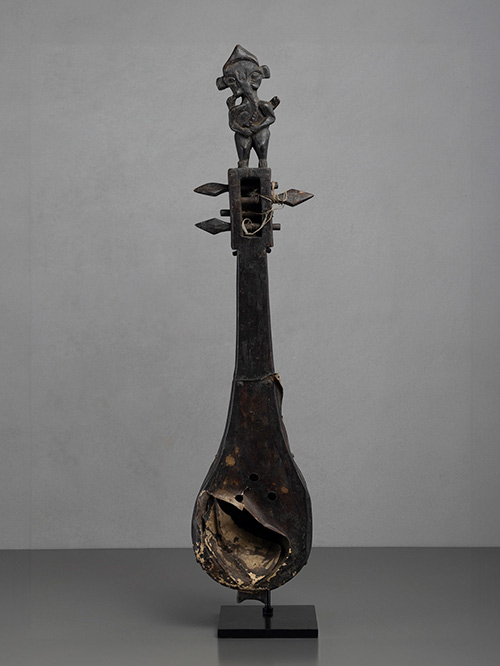

Santhals (North-Eastern India)
wood
A patinated and rare wooden instrument depicting Ganesha standing atop the peg box. The bottom half of the resonator is skin covered, most probably buffalo or goat hide.
The Santhals are the largest tribal community who live in the Indian states of Bihar, Orissa and West Bengal. Music is an important part of Santhal culture and the Santhal are gifted and passionate dancers and musicians and most of their songs and dances are related to various seasons and phases of life. A variety of sculptural instruments are used by the tribe, the most unique of which are the dhodro banam (hollow instrument).
The Santhal believe they are physically related to the dhodro banam and consider the instrument to be a human being. The dhodro banam is made of a single piece of wood, divided as such into distinct body parts such as the belly flanked with arms, open ribcage and a long neck ending in a head. The head is the key block and is often beautifully carved in the shape of a human head, a couple or whole groups of humans or animals.
The dhodro banam player holds the instrument vertically with its neck pointing upwards and the playing hand above the bow hand. The bow (banam ak) is made with horsehair and the string, and when strung brings life into the instrument through its vibrations.
Size (cms): 79(H) x 17(W) x 13.5(D)
Size (inches): 31(H) x 6.5(W) x 5.5(D)
-

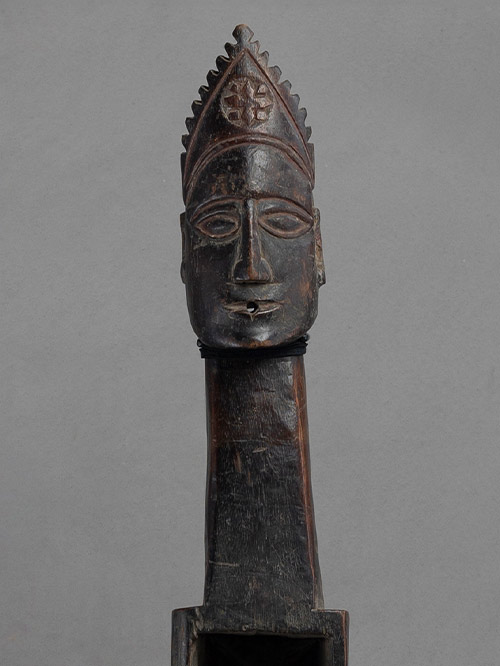
Santhals (North-Eastern India)
wood
A decorative and sculptural wooden instrument with an anthropomorphic form, featuring a peg box in the shape of a crowned head on top of a rectangular resonator. Fragments of the original resonator covering, most likely made from buffalo or goat hide, still remain on the lower half of the resonator.
The Santhals are the largest tribal community who live in the Indian states of Bihar, Orissa and West Bengal. Music is an important part of Santhal culture and the Santhal are gifted and passionate dancers and musicians and most of their songs and dances are related to various seasons and phases of life. A variety of sculptural instruments are used by the tribe, the most unique of which are the dhodro banam (hollow instrument).
The Santhal believe they are physically related to the dhodro banam and consider the instrument to be a human being. The dhodro banam is made of a single piece of wood, divided as such into distinct body parts such as the belly flanked with arms, open ribcage and a long neck ending in a head. The head is the key block and is often beautifully carved in the shape of a human head, a couple or whole groups of humans or animals.
The dhodro banam player holds the instrument vertically with its neck pointing upwards and the playing hand above the bow hand. The bow (banam ak) is made with horsehair and the string, and when strung brings life into the instrument through its vibrations.
Size (cms): 79(H) x 17(W) x 13.5(D)
Size (inches): 29(H) x 5(W) x 6(D)
-
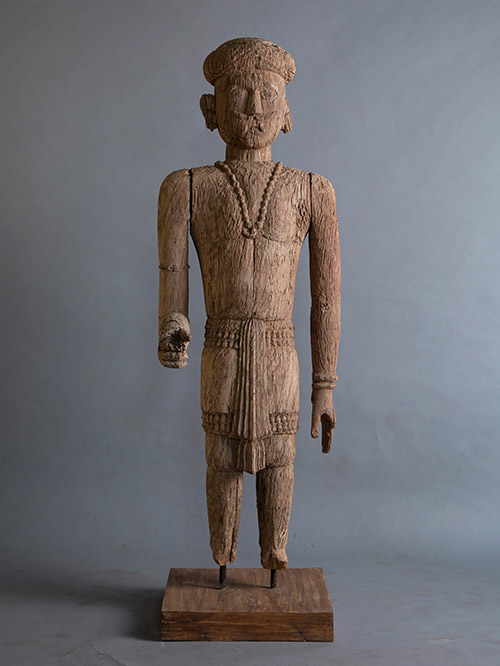

Coastal Karnataka (Bhuta culture)
Wood
A rare figure of a male donor chief. He wears a turban, has a prominent moustache and is decked with typical jewellery including a single strand necklace with a pendant, armlet and earrings. He wears an unstitched garment tied at the waist with pleats at the front, called a mundu.
The bhuta tradition is popular on the Malabar coast. Bounded by the dramatic sweep of the forested ghats to the east and the Arabian sea to the west, and encircled by rivers, the South Kanara district of coastal Karnataka has enjoyed relative geographic isolation until recent years. This has enabled the region to retain specific pre-Hindu belief systems and associated rituals, virtually intact, over several hundred years. These practices have a distinct identity of their own, although they have become linked in a variety of ways with mainstream Hinduism. Though now primarily confined to Coastal Karnataka, Bhuta cults once existed all over India under different names and forms. The factions, which are of considerable antiquity, have much in common with those of the yakshas (mysterious semi-divine beings), for instance.
Size (cms): 147(H) x 44(W) x 54(D)
Size (inches): 58(H) x 17.5(W) x 21.5(D)
-
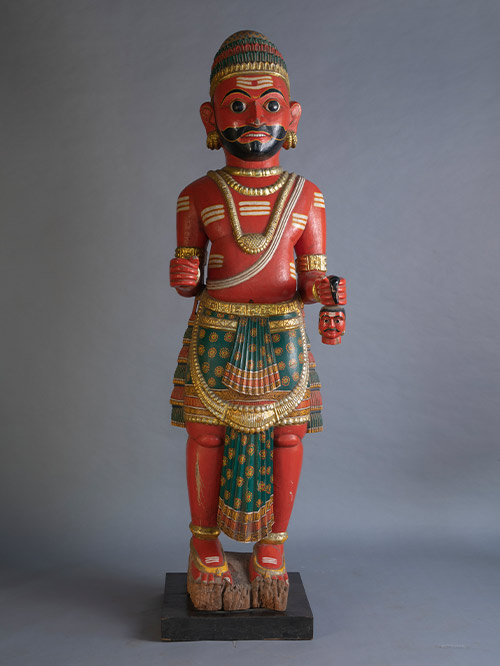
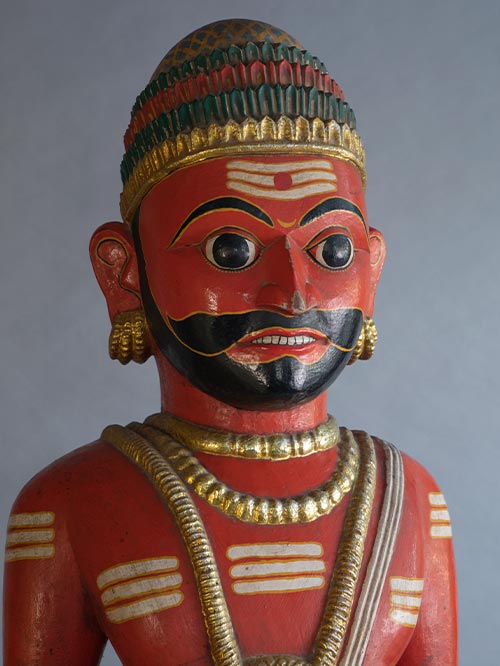
Coastal Karnataka (Bhuta culture)
Wood
A rare figure of a Virabhadra in the form of a Bhuta. He wears a turban, has a prominent moustache and beard and is decked with typical jewellery including a single strand necklace with a pendant, armlet and earrings. He wears an unstitched garment tied at the waist with pleats at the front, called a mundu. He carries in one hand the head of a slain enemy and in the other, he would have held a sword.
The bhuta tradition is popular on the Malabar coast. Bounded by the dramatic sweep of the forested ghats to the east and the Arabian sea to the west, and encircled by rivers, the South Kanara district of coastal Karnataka has enjoyed relative geographic isolation until recent years. This has enabled the region to retain specific pre-Hindu belief systems and associated rituals, virtually intact, over several hundred years. These practices have a distinct identity of their own, although they have become linked in a variety of ways with mainstream Hinduism. Though now primarily confined to Coastal Karnataka, Bhuta cults once existed all over India under different names and forms.
Size (cms): 188(H) x 56(W) x 56(D)
Size (inches): 74(H) x 22(W) x 22(D)
-
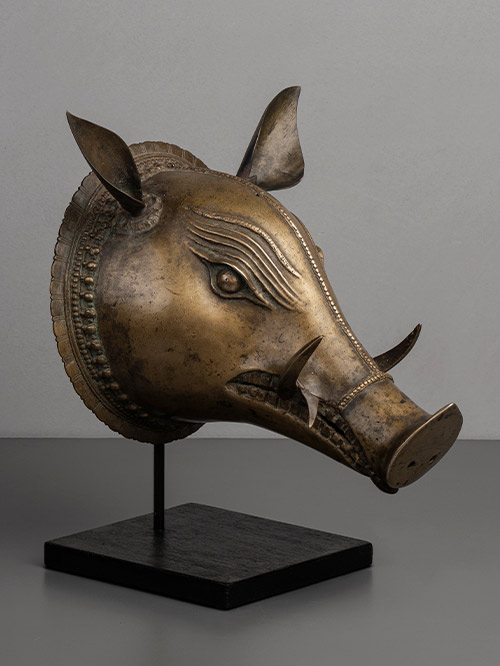
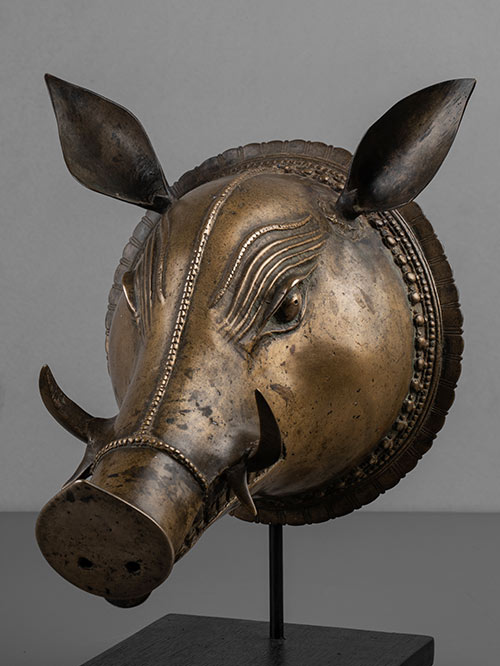
Coastal Karnataka (South India)
brass alloy
A finely detailed Panjurli (boar) mask with a symmetric conical shape, attractive colour, and rich patina. The head is adorned with a central vertical beaded rope that encircles the snout at one end and the head at its widest point. Features such as the eyes, ears, tusks, and snout are meticulously crafted.
This mask comes from the bhuta tradition on the Malabar coast. The bhuta and daiva, local divine or deified beings are highly prevalent in the southern parts of the Kannara district. Though now largely confined to south Kannara, certain areas of north Kannara and even Sri Lanka, bhuta cults once existed all over India under different names and forms. These cults, which are of considerable antiquity, have much in common with those of the yakshas, for instance. Like bhutas, yakshas are a ‘queer blend of what is sublime and mundane, profound and profane.’⠀
In Tulu Nadu, hordes of boars often invaded and destroyed the cultivated lands so the farmers started worshipping and giving offerings to Panjurli, the spirit in the form of a boar, thinking that this would appease his mood and thus keep the wild animals away from their fields.
Mask Size (cms): 27(H) x 26(W) x 33(D), 35(H with stand)
Mask Size (inches): 10.5(H) x 10(W) x 13(D), 14(H with stand)
-

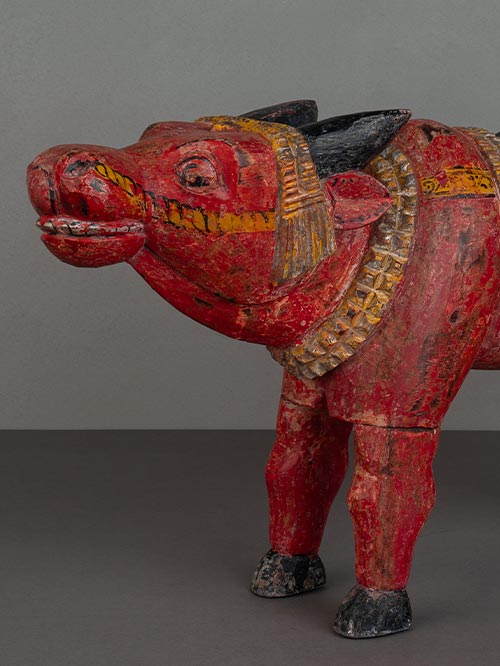
Coastal Karnataka (Bhuta culture)
Wood, polychromed
A fine painted wood figure of a standing nandi. Displaying the typical folk bhuta style of coastal Karnataka, this figure is painted predominantly in red with a painted saddlecloth and a curled back tail resting on its back.
The bhuta tradition is popular on the Malabar coast. Bounded by the dramatic sweep of the forested ghats to the east and the Arabian sea to the west, and encircled by rivers, the South Kanara district of coastal Karnataka has enjoyed relative geographic isolation until recent years. The totemic origin of this bull bhuta is quite obvious in a land of agriculture and farms where ploughs are pulled by bulls and where cow milk is one of the main sources of protein. The link with Hinduism is also easily established through Nandi the vahana (“vehicle”) of god Shiva.
Size (cms): 32(H) x 52(W) x 14(D)
Size (inches): 12.5(H) x 20.5(W) x 5.5(D)
-
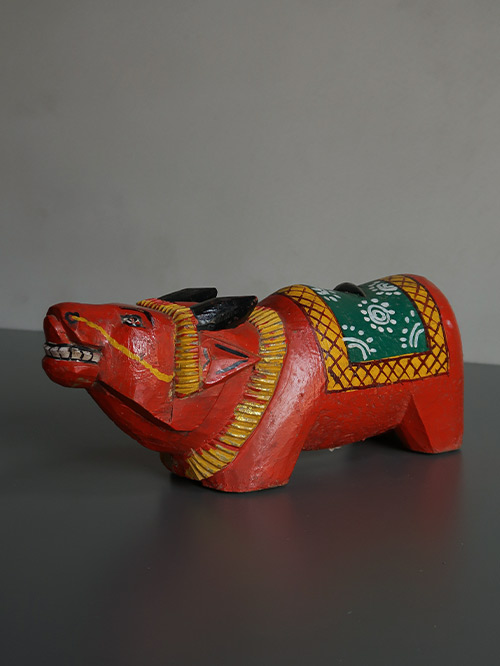
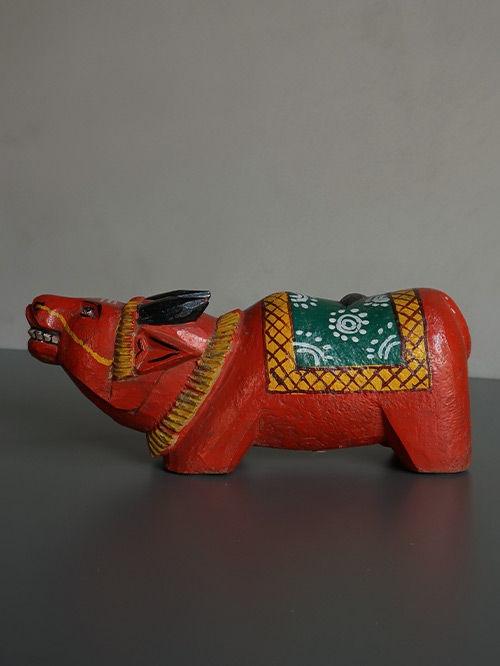
Coastal Karnataka (Bhuta culture)
Wood, polychromed
A fine painted wood figure of a standing nandi. Displaying the typical folk bhuta style of coastal Karnataka, this figure is painted predominantly in red It displays a typical stylised form with a horizontal head with slightly protruding tongue, horns adorned with ornaments, a floral painted saddlecloth and a curled back tail resting on its back.
The bhuta tradition is popular on the Malabar coast. Bounded by the dramatic sweep of the forested ghats to the east and the Arabian sea to the west, and encircled by rivers, the South Kanara district of coastal Karnataka has enjoyed relative geographic isolation until recent years. The totemic origin of this bull bhuta is quite obvious in a land of agriculture and farms where ploughs are pulled by bulls and where cow milk is one of the main sources of protein. The link with Hinduism is also easily established through Nandi the vahana (“vehicle”) of god Shiva.
Size (cms): 14(H) x 35.5(W) x 11(D)
Size (inches): 5.5(H) x 14(W) x 4.5(D)
-
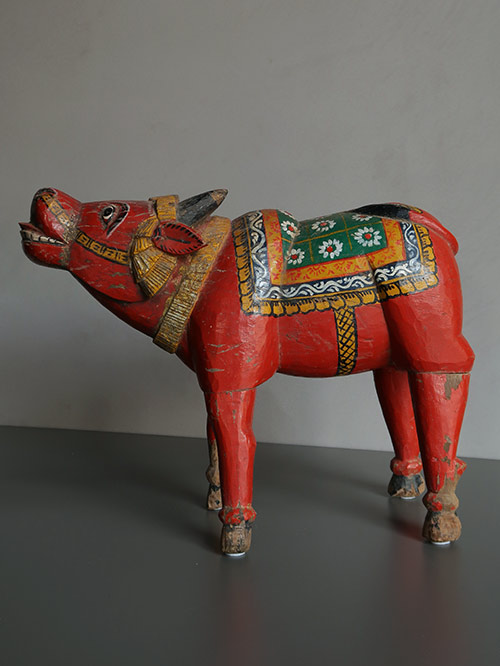
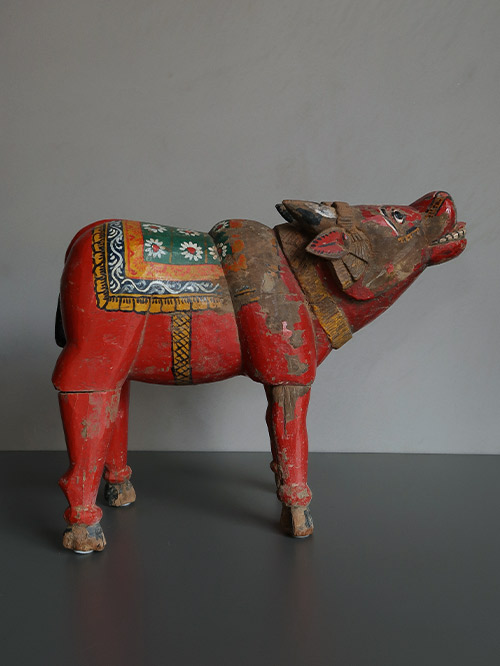
Coastal Karnataka (Bhuta culture)
Wood, polychromed
A large painted wood figure of a standing nandi. Displaying the typical folk bhuta style of coastal Karnataka, this figure is painted predominantly in red with a floral painted saddlecloth and a curled back tail resting on its back.
The bhuta tradition is popular on the Malabar coast. Bounded by the dramatic sweep of the forested ghats to the east and the Arabian sea to the west, and encircled by rivers, the South Kanara district of coastal Karnataka has enjoyed relative geographic isolation until recent years. The totemic origin of this bull bhuta is quite obvious in a land of agriculture and farms where ploughs are pulled by bulls and where cow milk is one of the main sources of protein. The link with Hinduism is also easily established through Nandi the vahana (“vehicle”) of god Shiva.
Size (cms): 36(H) x 46(W) x 16(D)
Size (inches): 14(H) x 18(W) x 6.5(D)
-

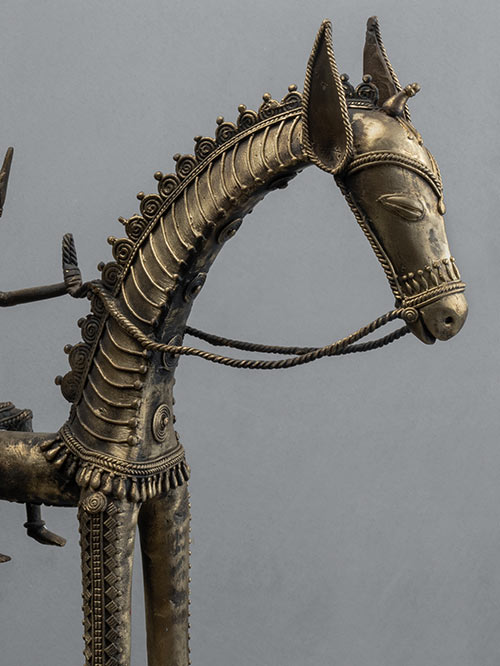
Bastar (Chhattisgarh, Central India)
Brass, Dokra work
A fine sculpture of a horse and four riders (hunters). The figures carry a spear, mace, club and a crocodile.
Suresh Waghmare (signed)
Born in 1970 in a Maharashtrian family in Bastar district, he began to study the technique of Bell Metal Casting with Guru Phool Singh Bisara when he was twelve. Since then he has been working as a member of the co-operative of craftsmen. He is a master craftsman in the art of metal casting and has participated in many international exhibitions.
Size (cms): 51(H) x 84.5(W) x 9(D)
Size (inches): 20(H) x 33.5(W) x 3.5(D)
-
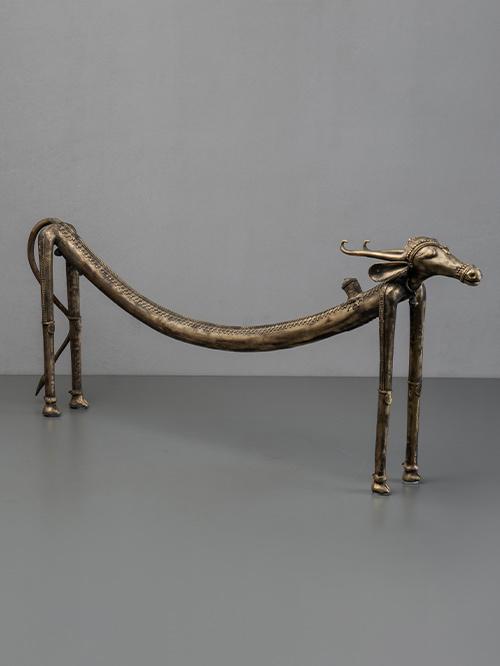
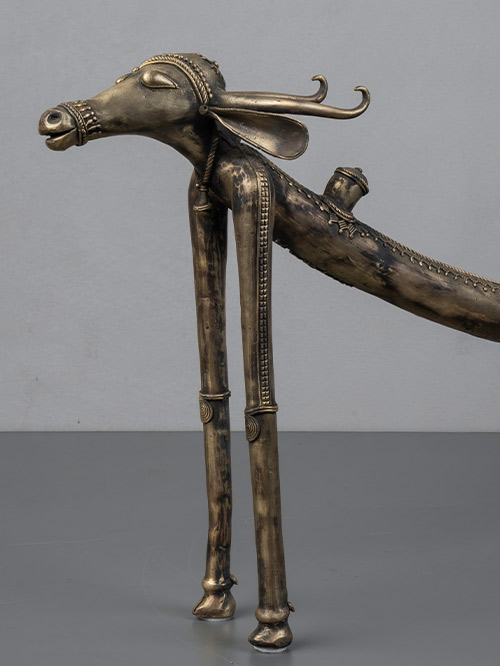
Bastar (Chhattisgarh, Central India)
Brass, Dokra work
Nandi or nandin means rejoicing, gladdening. It is the name of shivas conveyance (vahana) the white bull, son of kashyapa and of surabhi. Nandii was probably a folk deity later incorporated into the brahamanic lore. Nandi symbolises on the one hand moral and religious duty (dharma) , and on the other, virility, fertility and strength. Apart from being shivas vehicle, nandi in his form as nandikeshvara, depicted as a human with a bulls head, is believed to be one of the great masters of music and dancing. In southern India his recumbent image is placed either opposite the main sanctuary or in the hall leading to it, facing the linga.
Suresh Waghmare (signed)
Born in 1970 in a Maharashtrian family in Bastar district, he began to study the technique of Bell Metal Casting with Guru Phool Singh Bisara when he was twelve. Since then he has been working as a member of the co-operative of craftsmen. He is a master craftsman in the art of metal casting and has participated in many international exhibitions.
Size (cms): 38(H) x 81(W) x 10(D)
Size (inches): 15(H) x 32(W) x 4(D)
-
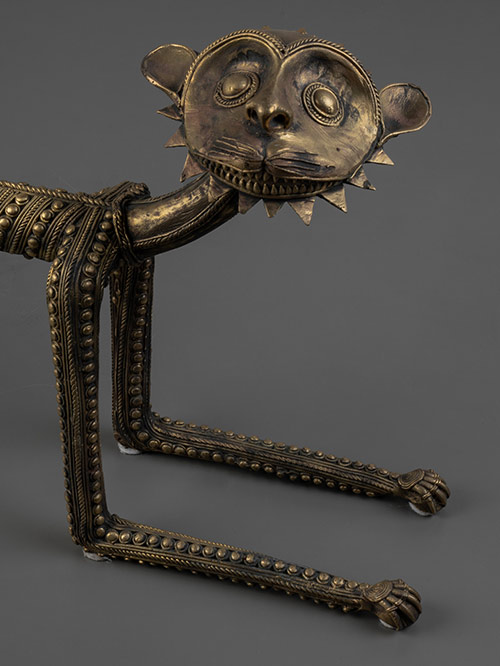
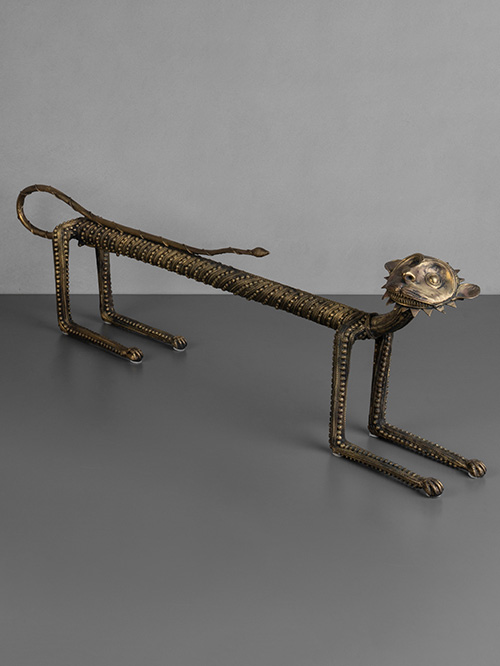
Bastar (Chhattisgarh, Central India)
Brass, Dokra work
The tiger is the vehicle of, and sacred to, Danteshwari Mata who is a form of the powerful Goddess Durga and is also the family goddess of the princes of Bastar.
Suresh Waghmare (signed)
Born in 1970 in a Maharashtrian family in Bastar district, he began to study the technique of Bell Metal Casting with Guru Phool Singh Bisara when he was twelve. Since then he has been working as a member of the co-operative of craftsmen. He is a master craftsman in the art of metal casting and has participated in many international exhibitions.
Size (cms): 29.5(H) x 106(W) x 11(D)
Size (inches): 11.5(H) x 41.5(W) x 4.5(D)
-
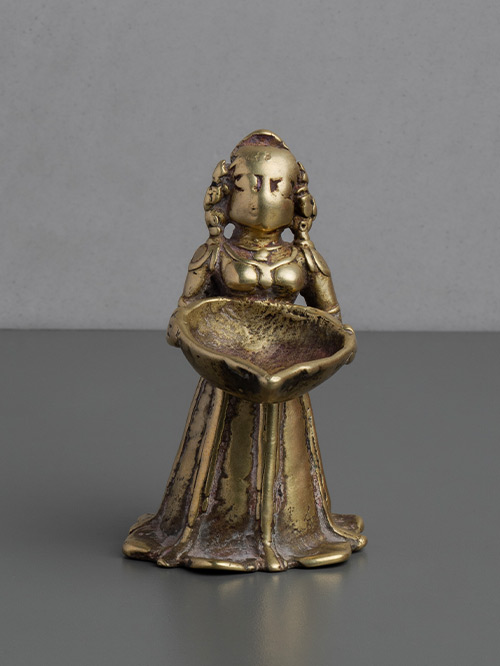

Karnataka
Brass alloy
This attractive and patinated Lakshmi of diminutive proportions stands proudly, holding a deep reservoir burner in her outstretched hands. She wears a long, flowing skirt that touches the floor. Her features, once delicately carved, have been partially worn by years of ritual use. Her hair is tied in a long braid that hangs along her back.
Dipalakshmi or Deepalakshmi is identifiable with Lakshmi, the Goddess of light and wealth. Dipalakshmi is usually shown holding the lamp bowl in her hands cupped in the gesture of anjali or offering of the flame of ‘divine light’ which, when lit kindles light into the image. The lamp is conceived as the vehicle through which the divine can be accessed. Lamps are used in rituals within the domestic realm, as well as religious or temple settings, in order to propitiate the gods.
Size (cms): 9.5(H) x 6(W) x 7.5(D)
Size (inches): 3.5(H) x 2.5(W) x 3(D)

































